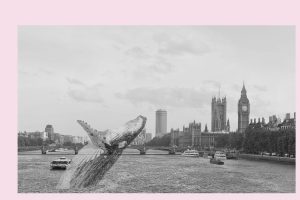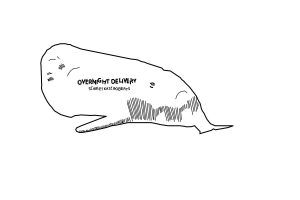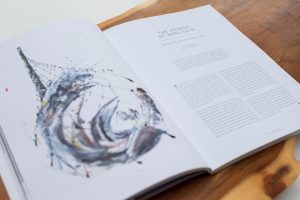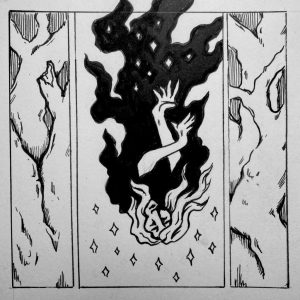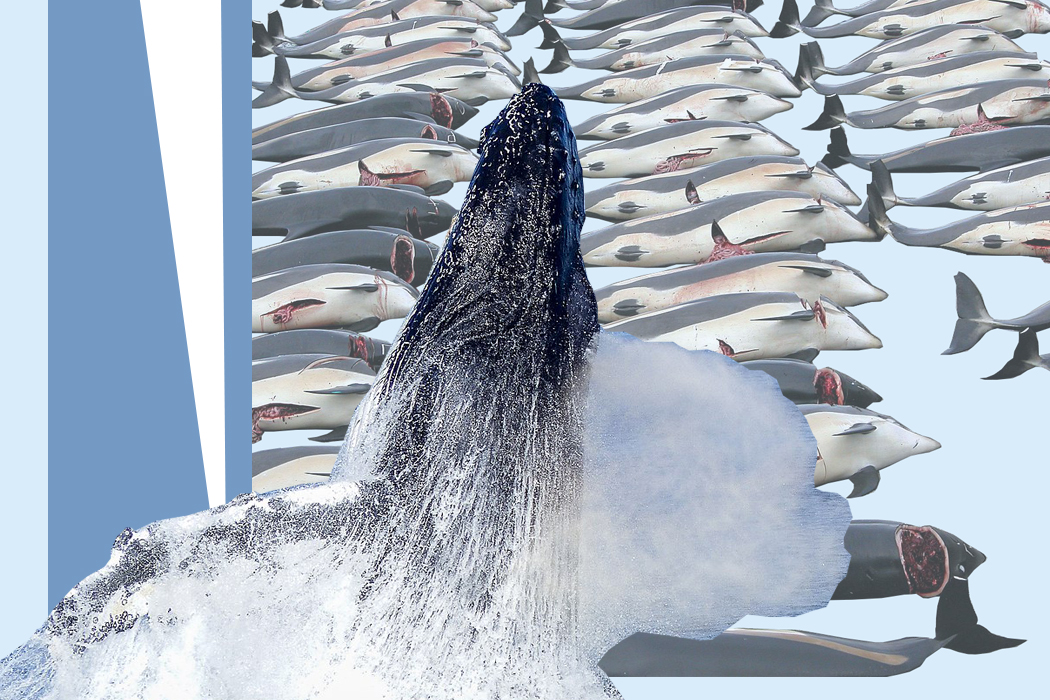
Lost at Sea
by Maggie Wang | April 18, 2020
The morning of 7 July 2018 dawned like any other at the whaling station of Hvalur hf, Iceland’s last extant commercial whaling company. Until it didn’t. The night before, one of the company’s whaling boats had returned from sea dragging its usual catch of a fin whale on one side, and something much more disconcerting on the other. The sun rose to reveal what appeared to be a blue whale lying on the ground surrounded by workers hurrying to harvest its meat. The species of this whale – Whale 22, the twenty-second catch of Hvalur hf’s whaling season – remains a subject for debate. Genetic testing carried out by the Marine and Freshwater Research Institute of Iceland (MFRI), a government institute operating within the Ministry of Industries and Innovation, determined that the whale was “a hybrid of a fin whale father and a blue whale mother”. However, numerous members of the scientific community – including a biologist at University College London and a researcher from the US National Oceanic and Atmospheric Administration – disputed this claim. Their doubts stemmed primarily from the whale’s appearance: its blue-grey colouration, light dorsal fin, and all-black baleen were typical traits of pure blue whales.
The distinction between hybrid and non-hybrid status is important because of a legal inconsistency that’s often overlooked – killing a blue whale is illegal both in Iceland and internationally, whereas killing a hybrid is only illegal under international law. This is not because hybrids are less valuable than blue whales; in fact, they are exceedingly rare. Hybrids cannot reproduce, and, because they do not belong explicitly to either species, they are not clearly protected by regulations concerning species with endangered status. The Icelandic government used this complexity as reasoning against protecting hybrids and condemning Hvalur’s actions. Some have argued that, regardless of Icelandic law, Hvalur hf ought to have faced consequences for this killing. After all, the MFRI report details that the samples used for comparison in the genetic testing of Whale 22 included genetic material from four proven hybrid specimens, all killed by Hvalur since 1983 and some, if not all, without a proper license. Only a month after MFRI released its report, Hvalur was accused of killing a second blue-fin hybrid, though this second killing seems to have slipped under the radar of the scientific community.
This controversy provides a unique moment of insight into the extended conflict surrounding whaling in Iceland. Hvalur survives largely due to the determination of one man: Kristján Loftsson. Loftsson, now aged 76, has controlled Hvalur since his father’s death in 1974. He grew up surrounded by whaling and first went to sea at thirteen, just as the industry was first booming. His company uses a refined version of an exploding harpoon designed in the 1860s. Despite the alleged conclusions of a 2013 report, which has never been released to the public, Loftsson refuses to discuss whether his killing methods cause pain to the animals he targets. A Google search for Loftsson’s name produces gory photographs of him posing with dead whales at his whaling station. He has never been one to shy away from controversy; again in the summer of 2018, he readily admitted to having killed eleven pregnant fin whales. Because Loftsson is one of the few remaining whalers in the world, it is difficult to draw meaningful conclusions about whether or not his practices are conventional. But his actions and claims scorn the possibility that whaling ethics and techniques in the 21st century ought to have evolved from those of the 19th.
Loftsson’s determination and confidence have not gone unchallenged. His chief critic for the past 35 decades has been Sea Shepherd, a marine conservation group with branches in twenty countries and projects including sea turtle conservation, wild salmon research, and hurricane relief. The group’s anti-whaling campaign, Operation Mjölnir, has released a photo and video documentation of Hvalur’s activities, shot from a hill above the company’s whaling station in Iceland. Sea Shepherd has played a key role in directing media scrutiny towards Hvalur. However, according to the International Fund for Animal Welfare, another group advocating against whaling in Iceland, Sea Shepherd’s techniques are no longer effective. Patrick Ramage, Director of Marine Conservation at IFAW, suggests that “while doubtless well-intended, ‘old style’ campaigns which attacked Loftsson and Hvalur hf historically had the unintended consequence of Icelanders circling the wagons, increasing resistance, and delaying the end of commercial whaling.” Few Icelanders speak out openly against Loftsson, and even his enemies admire him for his resilience. While Loftsson may be the main figure behind Icelandic whaling today – and a charismatic figure at that – the industry has much more complex roots, and successful advocacy in the future will require a fuller understanding of their nature.
Loftsson may have many enemies, but the system that has allowed him to evade them includes just as many supporters. Contrary to popular belief, Ramage explains that “whale hunting is not a longstanding cultural tradition in Iceland. Icelandic commercial whaling only started after 1935, when new legislation stated that only Icelanders could hunt in territorial waters. The industry really only commenced in 1948.” Yet Loftsson has managed to use rhetoric and his influence as a member of Iceland’s wealthy elite to sustain support for his whaling enterprise. Iceland was a founding member of the International Whaling Commission (IWC) when it was established in 1946, a multilateral organisation respected as the ultimate international authority on whaling. In 1982, the IWC adopted a moratorium on commercial whaling – a development highly unpopular with Icelandic policymakers. The country left the IWC in 1992. When attempting to rejoin in 2001, Iceland set forth a reservation to the moratorium on commercial whaling, meaning that it would refuse to abide by the moratorium and would continue to whale commercially at its own discretion.
At the Commission’s 2001 meeting, the representatives for Iceland explained that it had withdrawn from the IWC because it believed the body “had become a non-whaling commission rather than a whaling commission”. It felt encouraged to rejoin because it saw “signs that support is increasing within IWC for sustainable whaling in some form” and wanted “to have an influence on the discussions taking place”. Several countries objected, but Iceland argued that its reservation to the moratorium fell within the bounds of the IWC’s mission. Among the countries that defended Iceland were Norway, Japan, and Russia, all of which have an extensive history of commercial whaling. The matter was not resolved at that year’s meeting.
In 2002, a designated meeting of the IWC took place to further discuss Iceland’s membership. It culminated in a vote granting the country full membership of the IWC and accepting its reservation to the moratorium, which passed by a slim margin at nineteen votes in favour and eighteen against. Neither Iceland’s membership nor the accompanying reservation have ever gained widespread acceptance. Sixteen countries maintain a formal objection to Iceland’s reservation, while three others consider the country’s membership invalid. Of these countries, the United States is the only one with a significant whaling presence. On the other hand, few support the idea that Iceland’s pursuit of whaling might be unethical or environmentally dangerous. Even the countries that do question Iceland’s activities have failed to translate their politics into practice, as most maintain trade agreements and strong diplomatic relationships with Iceland.
In this century, the financial prospects of the Icelandic whaling industry have never been rosy. Almost all of the meat harvested by Hvalur is exported to Japan, where consumption of whale meat has been in steady decline and will likely decline further following the controversy of Japan’s own withdrawal from the IWC. Few shipping companies are still willing to transport whale meat, and Japan’s restricted food safety standards have become increasingly difficult for Hvalur to meet. Outside of Japan, Hvalur’s main prospects lie in selling whale meat to tourists in Iceland, but this, too, is no longer a particularly promising business strategy. In the summer of 2001, IFAW launched the “Meet Us Don’t Eat Us” campaign alongside IceWhale, the Icelandic Whale Watching Association. The campaign aims to decrease the consumption of whale meat among tourists and render whale hunting economically unsustainable. So far, over 100,000 visitors have signed the campaign’s pledge – a success no doubt driven by the increased popularity of whale watching as a tourist activity. Ramage is confident that IFAW will continue to “promote whale watching as a sustainable alternative and encourage Icelanders and visitors to enjoy living whales in their natural environment”.
In polls conducted by IFAW and Gallup in October 2019, 89 percent of Icelanders said they had never eaten whale meat, while only 1.2 percent said that they ate it six or more times in a year. Many Icelandic restaurants have stopped serving whale meat, and even though there is still a market for it, eating whale no longer has significant economic or cultural weight. Despite increasing nationalism in Iceland and elsewhere, whaling seems to be one issue, Ramage suggests, where Icelanders are looking forward and outward: “Icelanders increasingly perceive [Hvalur] as representing the old ways of doing things. Hvalur uses outmoded nationalist arguments to try and rally support for an unsustainable, uneconomic activity that undermines Iceland’s actual interests. Those arguments no longer cut ice, even in Iceland.” Kristján Loftsson disagrees, and he has continued to search for new ways to keep his company alive. He has invested in whaling in Norway, and is reportedly considering turning whale meat into a nutritional powder. In reality, Hvalur’s financial success no longer comes from whaling; in 2014, the company’s whaling operations made a loss of £4.8 million. Its overall profits of £14.3 million that year were attributable to its ownership of Vogun hf, which, in turn, owns one-third of HB Grandi, a prominent fishing company.
Perhaps the success of Hvalur’s investment in fishing has actually encouraged Loftsson to persist in his whaling enterprise. Since 2007, Hvalur’s catches have averaged 141 fin and 38 minke whales, excluding years when each type was not hunted. Norway also continues to hunt around 500 minke whales each year, but unlike fin whales, minke whales are not endangered. Due to difficulties in obtaining a permit for the season, Hvalur did not whale in 2019. It has yet to announce its plans for 2020, but, either way, tensions between Loftsson and the advocacy community are not going to disappear. Loftsson may face international criticism, but the Icelandic government continues to tacitly support him. Ramage predicts that “permanently ending Icelandic whaling has to be a genuinely Icelandic decision based on Icelandic leaders’ focus on their country’s interests”. Most likely, it will be economic factors that eventually force Loftsson to abandon whaling. This might take years.
In the meantime, Loftsson will continue to use nationalist arguments to legitimise pseudo-nationalist activities which are less than a century old. He will continue to pay millions of króna to slaughter ecologically pivotal creatures, and he will thrive on adrenaline and the “whale blood” which he claims is running through his veins. In Iceland, after all, his career is comparable to that of a beef or chicken farmer in Britain. Sigursteinn Masson, project leader for IceWhale, explains: that “for Icelanders, there is nothing obvious about […] the unethical nature of killing whales. This is to people here debatable just as other animal killings are.”
To some Icelanders, whaling represents national agency and human control over the natural world. The International Union for Conservation of Nature may consider fin whales endangered, but advocates cannot take the impropriety of whaling for granted. Protecting whales is tantamount to ensuring the stability of marine ecosystems. For the foreseeable future, though, Loftsson and the Icelandic government will continue to look to culture, history, and self-interest to justify the killing of whales.∎
Words by Maggie Wang. Art by Xander Haveron-Jones.
